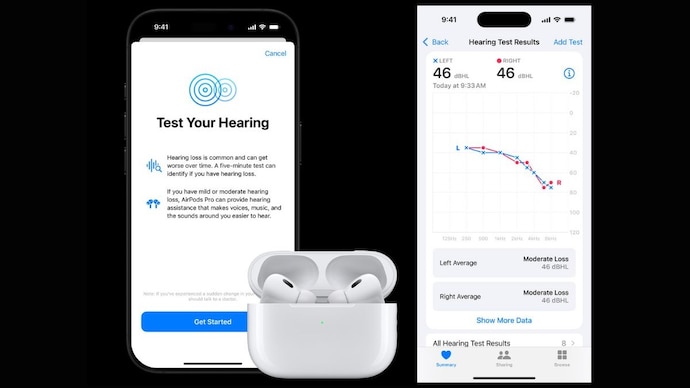iOS 18.1 brings new hearing health feature: Here’s how you can take a hearing test using your AirPods Pro 2
Apple’s iOS 18.1 update brings a new hearing health feature for AirPods Pro 2 users. This new feature allows users to take clinical-grade hearing tests from their iPhones or iPads, providing insight into their hearing health.
listen to the story

The iOS 18.1 update has finally introduced Apple’s much-awaited Hearing Health feature. Apple unveiled this new feature during the iPhone 16 launch earlier this year, aiming to provide more accessible health tools to AirPods Pro 2 users, especially those who don’t have access to traditional hearing assessments. . Approved by the Food and Drug Administration, Apple’s Hearing Health feature allows users to take a clinical-grade hearing test using AirPods Pro 2 to assess and track their hearing health right from their iPhone or iPad.
Apple highlighted that millions of people around the world are unaware that they are living with hearing loss and may not realize their condition until it impacts their daily lives. Starts doing it. With the Hearing Health feature, Apple aims to make it easier for users to get an indication of their hearing without the need to go to a clinic. This test, conducted using the AirPods Pro 2, examines a range of frequencies and provides users with insight into their hearing ability based on decibel hearing levels (dBHL).
Here’s a detailed step-by-step guide on how you can use your AirPods Pro 2 to check your hearing health:
How to test hearing health with AirPods Pro 2
Before you start testing, make sure you’re using an iPhone or iPad with iOS 18.1 or later and your AirPods Pro 2 are updated with the latest firmware.
Make sure your AirPods Pro 2 fit securely and form a good seal in your ears, as fit is important for accurate test results. Use the ear tip fit test in device settings to confirm fit. You can also try different ear tip sizes or clear the earbuds for a better seal.
Make sure you are in a quiet environment to avoid interference from background noise. The test involves tones at different volumes and frequencies, so even subtle background noise can affect the results. Apple recommends testing in a quiet room, ideally without fan or AC noise, and setting aside about five minutes without any interruptions.
Open the Settings app, navigate to your connected AirPods and look for the “Take a hearing test” option. You can also start the test by going to the Hearing section from the Health app.
Once you tap “Take a hearing test,” follow the on-screen prompts. If any checks need to be done, like ensuring a quiet environment or confirming the AirPods fit, the app will notify you.
During the test, you will hear a series of tones at different frequencies. When you hear a tone, just tap the screen. These tones are repeated several times to ensure accuracy in case you miss the beginning.
If the test detects an improper fit or other problems, it may stop and prompt you to make adjustments, such as trying a different ear tip or moving to a quieter location.
After the test, you will see a summary of your hearing results in decibels at hearing level (dBHL), providing an overview of your hearing ability.
for reference:
Up to 25 dBHL: Little or no hearing loss.
26-40 dBHL: mild hearing loss; You may have difficulty hearing normal speech from a distance.
41-60 dBHL: moderate hearing loss; Loud noises may be necessary.
61-80 dBHL: severe hearing loss; Understanding speech usually requires shouting.
To get a more in-depth analysis, tap “Show Details” to see a frequency-specific chart of your listening levels. Apple notes that this audiogram is stored securely in the Health app and can be shared as a PDF with healthcare providers for further consultation.





